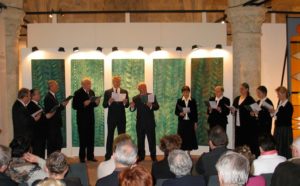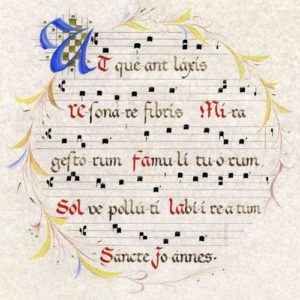Organization
The songs of the Gregorian mass of 9:00 am in the Cathedral are assured by the Gregorian Choir. This choir, composed of 15 men and women in its complete formation, exists in its present form since the beginning of 2001.
In order to interpret with dignity the songs performed according to the rules defined by the abbey of Solesmes and ratified by the Church, the choir works regularly every Friday evening in the rectorate of the Cathedral.
The choir performs mainly on Sundays during the Gregorian Mass, as well as once a quarter for Gregorian vespers, in the ordinary form of the Roman Rite, with the participation of the choir organ and the Great organ.
On certain more solemn occasions, polyphonic pieces may be performed, including alternate psalms in ‘faux-bourdons’.
The choir, still small, needs to grow. Therefore, we are calling on people who love sacred singing, who have some knowledge of musical deciphering, who sing in tune and who are committed to attending weekly rehearsals as regularly as possible to join the Gregorian Choir of the Cathedral.

Gregorian chant, the basis of music…
Gregorian chant, church chant par excellence, takes its name from Pope Saint Gregory the Great, who was pope from 590 to 604, who undertook a great liturgical reform and codified sacred chant by collecting the previous repertoire, choosing the most appropriate pieces, ordering them and modifying them to make them more suitable for accompanying religious ceremonies.
In the seventh century, when the liturgy reached its golden age, the repertoire was extended, the technique was enriched and the whole of sacred chant reached a complete perfection.
As early as the third century, the Latin language had already taken the first place as the language of worship. Forged by masters such as Tertullian and St. Cyprian, Christian Latin was led by St. Ambrose and St. Augustine, and later by the popes St. Leo and St. Gregory, to a perfection that allowed it to express with nobility and conciseness, the riches of doctrine, the sentiments of piety and the nuances of melody.
But where does this restored chant come from? Some pieces come from the Jewish liturgy in force at the time of Christ (psalms, Te Deum …), others have their origin in Greek music (Kyrie eleison, Agios o Theos …).
We can say that Gregorian chant was formed from the 4th to the 6th century, that it was perfected from the 7th to the 13th century, that it entered into decadence from the 14th to the 19th century and that it was restored to its original qualities from the middle of the 19th century onwards under the determining impulse of the Benedictines of the Abbey of Solesmes, where Dom Gueranger became famous, Dom Jaussions, Dom Pothier and especially Dom Mocquereau who launched in 1889 the “Paléographie musicale”, a publication which was to become an authority in the scientific study of Gregorian restoration. The work of Solesmes has been regularly approved by all the Pontiffs since Leo XIII.
Gregorian notation is written on a four-line staff with square neumes that sweep across the usual scale (C or ut, D, E, F, G, A, B) common with modern notation.

This scale comes from the hymn of Saint John the Baptist which is still sung at the 2nd vespers of his feast day and whose first verse is the following:
| Ut queant laxis |  | Afin que tes serviteurs, | |
| Resonare fibris | à pleine voix, | ||
| Mira gestorum | puissent chanter | ||
| Famili tuorum, | les merveilles de tes actions, | ||
| Solve polluti | libère | ||
| Labii reatum | nos bouches closes, | ||
| Sancte Joannes | ô Saint Jean Baptiste. |
||
The initial syllable of each hemistiche rises by one degree in the scale of sounds. At the beginning of the 11th century, Guy d’AREZZO, a monk from Pomposa near Ferrara, used this particularity to give the notes the name of these syllables: Ut (C), Re (D), Mi (E)… He also created a system of regular lines on which the notes would be placed. Saint John the Baptist and his hymn are thus at the origin of two essential tools of the musical art: the scale and the staff.
Although arbitrarily set aside in religious ceremonies for some years, Gregorian chant remains the cornerstone of Catholic expression in the liturgy.
Let us recall, in fact, that the conciliar constitution of the Second Vatican Council (Art.36 §1 and 116) states:
“The Church recognizes in Gregorian chant the proper chant of the Roman liturgy; it is therefore the chant that, in liturgical actions, all things being equal, must occupy the first place”.
The Gregorian chant in force in the Church includes:
- the Kyriale alternating with the congregation: Kyrie, Gloria, Sanctus, Agnus (18 different Kyriales),
- the Credo also alternated with the assembly (7 different Credos),
- the pieces of the Gregorian Proper specific to the feast or Sunday of the day:
– the introït,
– the gradual or the alleluia n°1,
– the alleluia n° 2 or the trait (penitential time),
– the sequence, if applicable,
– the offertory,
– the communion,
- the psalms in 9 modes with different final cadences,
- the antiphons,
- the hymns,
- the motets.
For the musician, Gregorian chant is a source of melodic inspiration. For every man, it is a ferment of spiritual exaltation.
But, for the believer, it is above all this sung prayer where a deep faith lives and where an ardent fervor burns. It is the privileged place of the Catholic spirituality and the music of the interior life.